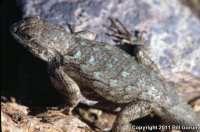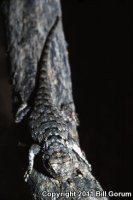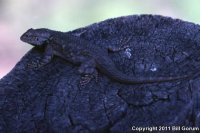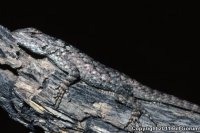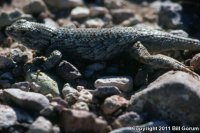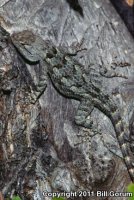| Range: |
 |
| Other Names: |
|
| Subspecies: |
Sonoran Spiny Lizard Sceloporus clarkii clarkii |
| Description: |
A large (up to 144 mm or 5.6" from snout to vent), stocky lizard with large, pointed, keeled, overlapping scales. Base coloration is blue-gray, gray, or gray-brown, often with powder blue or blue-green accents of the body and tail. A dark wedge-shape marks each shoulder and there are dark, bracelet-like crossbars on the forelimbs. Juvenile animals and females often have brown or gray crossbars on the body. Males have a large blue or blue-green patch on each side of the belly and one on the throat. These patches are often outlined with black. Belly and throat patches are faint or lacking in females. |
| Similar Species: |
Its dark, wedge-shaped shoulder markings distinguish this lizard from the smaller Southwestern Fence Lizard (Sceloporus cowlesi), the Striped Plateau Lizard (Sceloporus virgatus) and Slevin's Bunchgrass Lizard (Sceloporus slevini). The bars on its forelimbs distinguish it from the Desert Spiny Lizard and the Twin-spotted Spiny. The similar Yarrow's Spiny Lizard has a complete collar. |
| Venom: |
None |
| Habitat: |
Clark's Spiny Lizard is found in a variety of biotic communities including Arizona Upland Sonoran Desertscrub, Semidesert Grassland, Interior Chaparral, Madrean Evergreen Woodland and Great Basin Conifer Woodland. It is usually encountered on lower mountain slopes, in foothills, and along riparian corridors. |
| Behavior: |
This diurnal lizard is often spotted basking on the branches of trees. It is less frequently seen basking on boulders and rock outcroppings. When encountered this wary lizard scurries to the opposite side of the trunk and up into the safety of the high branches. It also seeks shelter under boulders and in crevices. |
| Hibernation: |
It hibernates during the cold months of winter and late fall. |
| Reproduction: |
Mating takes place in spring and a clutch of up to 28 eggs is laid in June. Some females may lay an additional, smaller clutch of eggs. |
| Diet: |
Clark's Spiny lizard feeds on a variety of insects including beetles, ants, caterpillars, wasps, moths, butterflies, grasshoppers, bugs, aphids, cicadas, and crickets. It also feeds on a variety of spiders and some plant material.
|
Sources:



|


